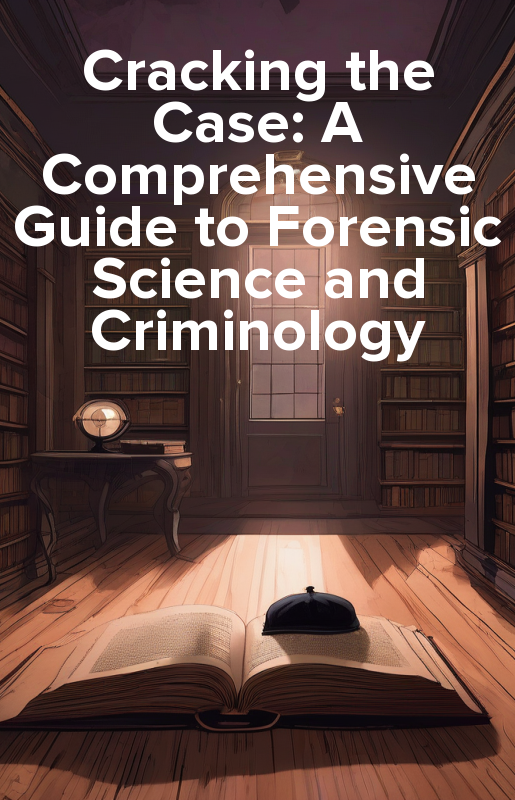Table of contents for ebook and audiobook: „Cracking the Case: A Comprehensive Guide to Forensic Science and Criminology”
Here's the translation of the provided text to English:
The Body in the Library: A Comprehensive Guide to Forensic Science and Criminology
Part 1: Introduction to Forensic Science
Chapter 1: History of Forensic Science
- 1.1 Early Beginnings of Forensic Science
- 1.2 Development of Modern Forensic Science
- 1.3 Key Figures in the History of Forensic Science
- 1.4 Impact of Technology on Forensic Science
- 1.5 Future Directions of Forensic Science
Chapter 2: The Role of Forensic Science in Crime Investigation
- 2.1 The Importance of Forensic Science in Solving Crimes
- 2.2 The Role of Forensic Scientists in Crime Scene Investigation
- 2.3 Forensic Science and the Law
- 2.4 Forensic Science and the Media
- 2.5 The Impact of Forensic Science on Crime Prevention
Part 2: Forensic Analysis of Physical Evidence
Chapter 3: Fingerprint Analysis
- 3.1 History of Fingerprint Analysis
- 3.2 Types of Fingerprint Patterns
- 3.3 Fingerprint Comparison and Identification
- 3.4 Automated Fingerprint Identification Systems (AFIS)
- 3.5 Limitations and Challenges of Fingerprint Analysis
Chapter 4: DNA Analysis
- 4.1 History of DNA Analysis
- 4.2 Types of DNA Analysis
- 4.3 DNA Profiling and Identification
- 4.4 DNA Evidence in Court
- 4.5 Limitations and Challenges of DNA Analysis
Chapter 5: Bloodstain Pattern Analysis
- 5.1 History of Bloodstain Pattern Analysis
- 5.2 Types of Bloodstain Patterns
- 5.3 Bloodstain Pattern Analysis and Interpretation
- 5.4 Bloodstain Pattern Analysis in Court
- 5.5 Limitations and Challenges of Bloodstain Pattern Analysis
Part 3: Forensic Analysis of Digital Evidence
Chapter 6: Computer Forensics
- 6.1 History of Computer Forensics
- 6.2 Types of Digital Evidence
- 6.3 Digital Evidence Recovery and Analysis
- 6.4 Digital Evidence in Court
- 6.5 Limitations and Challenges of Computer Forensics
Chapter 7: Mobile Device Forensics
- 7.1 History of Mobile Device Forensics
- 7.2 Types of Mobile Device Evidence
- 7.3 Mobile Device Evidence Recovery and Analysis
- 7.4 Mobile Device Evidence in Court
- 7.5 Limitations and Challenges of Mobile Device Forensics
Chapter 8: Network Forensics
- 8.1 History of Network Forensics
- 8.2 Types of Network Evidence
- 8.3 Network Evidence Recovery and Analysis
- 8.4 Network Evidence in Court
- 8.5 Limitations and Challenges of Network Forensics
Part 4: Forensic Psychology and Profiling
Chapter 9: Forensic Psychology
- 9.1 History of Forensic Psychology
- 9.2 Types of Forensic Psychology
- 9.3 Forensic Psychology and the Law
- 9.4 Forensic Psychology and Crime Prevention
- 9.5 Limitations and Challenges of Forensic Psychology
Chapter 10: Crime Scene Profiling
- 10.1 History of Crime Scene Profiling
- 10.2 Types of Crime Scene Profiling
- 10.3 Crime Scene Profiling and Investigation
- 10.4 Crime Scene Profiling in Court
- 10.5 Limitations and Challenges of Crime Scene Profiling
Part 5: Conclusion and Future Directions
Chapter 11: Conclusion
- 11.1 Summary of Key Points
- 11.2 Future Directions of Forensic Science
- 11.3 Challenges and Limitations of Forensic Science
- 11.4 Conclusion and Recommendations
Note that the title of the book is quite peculiar. "The Body in the Library" is a classic Agatha Christie novel, but it seems unrelated to the content of the book, which appears to be a comprehensive guide to forensic science and criminology.

